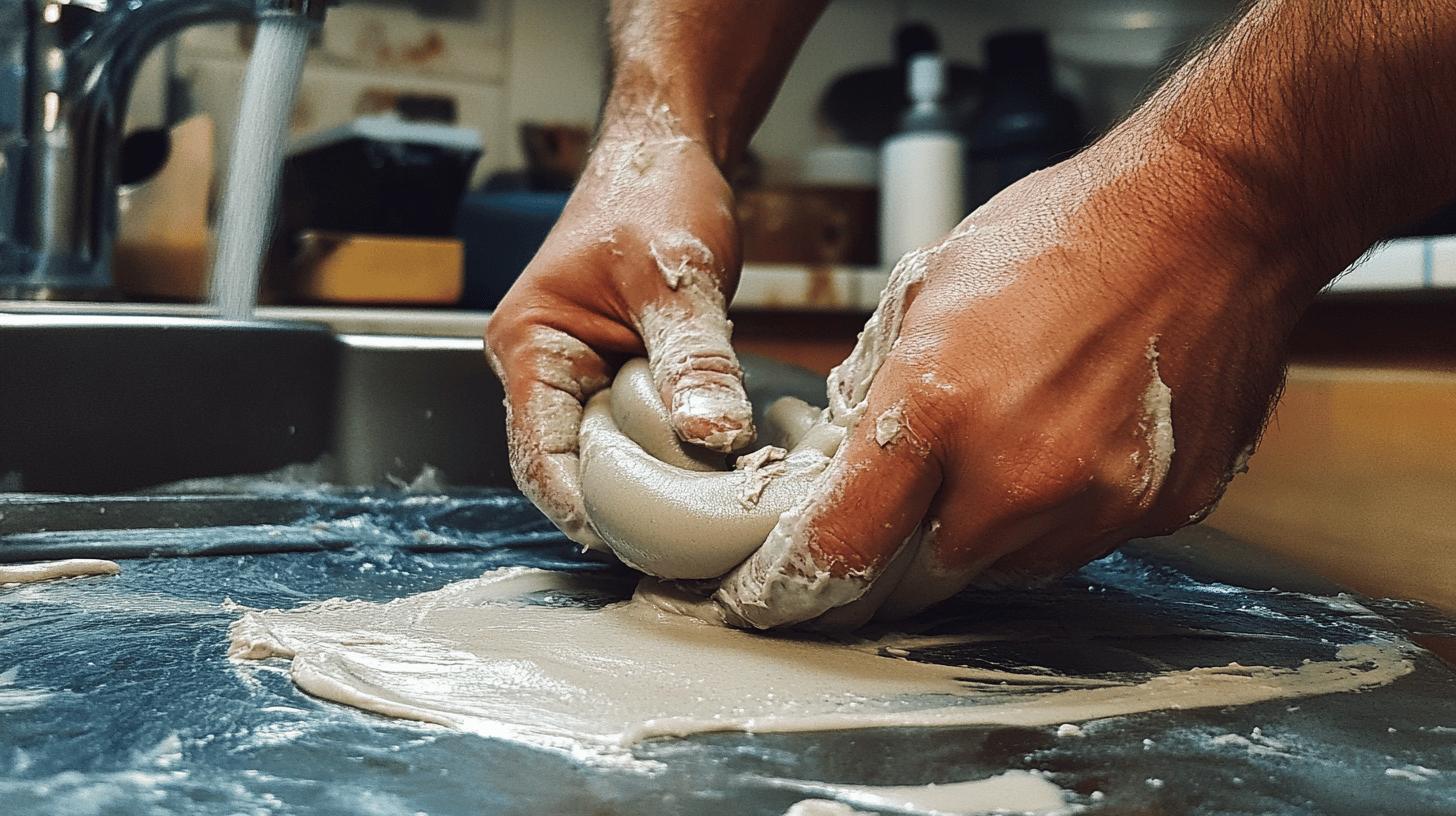TL;DR:
- What is Plumbing Putty? A flexible sealant for non-pressured pipes, ideal for temporary fixes.
- Uses: Kitchen faucets, garbage disposals, basket strainers, tub drains, pop-up assemblies.
- Limitations: Not for high-pressure scenarios; use Teflon tape instead.
- Application Steps: Clean the surface, warm & roll putty, apply, remove excess, tighten fixtures.
- Comparison with Silicone: Putty is flexible and adjustable; silicone is permanent and durable for high-pressure areas.
- Where to Buy: Available at Home Depot, Lowe’s, and Amazon; aim for recognized brands like Oatey.
- Best Practices: Avoid porous surfaces, ensure cleanliness, store in sealed containers, follow manufacturer instructions.
Did you know that a simple tub of plumber’s putty can be your first defense against pesky leaks in non-pressurized pipes and fixtures? Many homeowners overlook this versatile compound, but it’s an easy and cost-effective solution for minor leaks. Plumber’s putty forms watertight seals around faucets, drains, and other plumbing fixtures, preventing water from escaping. Understanding the role of plumber’s putty is crucial for anyone looking to handle everyday plumbing challenges without breaking the bank. Dive in to learn how this handy tool can save you time, money, and stress on your plumbing repairs.
Understanding Plumbing Putty: A Key to Stopping Leaks
Plumbing putty is a must-have for any plumber. Its soft, flexible texture makes it perfect for creating seals around fixtures. Made from clay and oils that keep it pliable, plumbing putty is ideal for fixing leaks in non-pressurized pipes. It’s especially useful for seals that may need to be adjusted or removed later, as it doesn’t harden. This flexibility and ease of use make it a go-to solution for stopping leaks and preventing water damage in homes.
Uses include:
- Sealing kitchen faucets
- Fixing garbage disposals
- Installing basket strainers
- Sealing tub drains
- Pop-up assemblies
Plumbing putty is a great solution for many tasks, but it does have its limits. It’s not suitable for high-pressure situations or sealing pipe threads—Teflon tape or pipe-joint compounds are better choices for these. Additionally, plumbing putty can stain porous surfaces, so it’s best to use non-staining types on sensitive areas. When used properly, however, plumbing putty is an efficient and quick fix for minor leaks, making it an invaluable tool for both DIYers and professional plumbers.
How to Apply Plumbing Putty for Maximum Effectiveness

Before applying plumbing putty, it’s important to prepare the surface. Clean and dry the area thoroughly to ensure a proper seal. Any dirt, grease, or moisture can affect how well the putty sticks. Start by wiping the surface with a clean cloth, making sure to remove any dust or old sealant. A dry surface will help the putty bond properly, setting you up for a successful application.
- Clean and dry the surface.
- Warm the putty in your hands until it’s pliable.
- Roll it into a snake-like shape.
- Press it firmly around the area needing a seal.
- Remove any excess putty.
- Tighten fixtures to secure the seal.
Precision matters when applying plumbing putty for a durable seal. Warm the putty slightly to make it more flexible, making it easier to work with. Apply even pressure to fill gaps and ensure a tight fit. After application, remove any excess putty for a cleaner look and to maintain a strong seal. Tighten fixtures to compress the putty, helping it form a reliable seal. Following these steps ensures the putty works efficiently, providing a quick and lasting fix for leaks.
Comparing Plumbing Putty and Silicone: Which is Better for Leak Prevention?
Plumbing putty and silicone sealant each have their strengths, but they serve different purposes. The main difference is in their flexibility. Plumbing putty remains soft and pliable, making it easier to adjust or remove, while silicone hardens over time to form a permanent seal. This gives putty an advantage for temporary fixes, such as around faucets and drains, where you may need to make adjustments later.
Silicone, on the other hand, is ideal for permanent, high-pressure applications, like joint sealing or tub waterproofing, where durability and strong adhesion are key. It’s perfect for areas that require a permanent, watertight seal, such as shower stalls or bathtubs.
When choosing between the two, think about the job at hand. Use plumbing putty for seals you might need to adjust or remove, and choose silicone when you need a long-lasting, permanent seal in areas exposed to constant moisture or high pressure.
Where to Buy Quality Plumbing Putty

Plumbing putty is easy to find at both online retailers and home improvement stores. In physical stores, well-known chains offer various brands, while online platforms give you access to a broader selection with the added benefit of customer reviews to guide your decision.
When choosing a brand, go for recognized names like Oatey, which offer quality options, including stain-free varieties. These are versatile and safe for most materials. Oatey products, when stored properly, can last up to two years. Opting for reputable brands ensures you’re getting a reliable and effective product for your plumbing needs.
| Store/Brand | Features | Availability |
|—————|————————————|————————|
| Home Depot | Stain-free options, durable | In-store/Online |
| Lowe’s | Wide selection, customer reviews | In-store/Online |
| Amazon | Variety of brands, convenient | Online only |
Common Mistakes and Best Practices with Plumbing Putty
Common mistakes with plumbing putty include using the wrong type for the surface, like applying it to porous materials such as marble, which can cause staining and damage. Another mistake is applying the putty without properly cleaning and drying the surface, which prevents it from bonding effectively, leading to weak or ineffective seals. Not following the manufacturer’s instructions can also result in poor performance, as improper application may affect the durability of the seal. Always ensure you’re using the right putty for the job, prepare the surface correctly, and adhere to the product guidelines for the best results.
Guidelines include:
- Avoid use on porous surfaces like marble.
- Ensure surfaces are clean and dry beforehand.
- Store putty in a sealed container.
- Opt for non-staining putty for sensitive materials.
- Follow manufacturer’s instructions closely.
Proper storage is key to keeping plumbing putty effective. Always store it in a sealed container to prevent it from drying out or hardening. This helps maintain its flexibility and makes it ready for use when needed. Keep it in a cool, dry place to preserve its consistency and ensure it’s in good condition for future plumbing tasks.
Final Words
In this guide, you’ve learned the key aspects of using plumbing putty to effectively prevent leaks. From its composition and primary applications to mastering the best techniques for applying it, plumbing putty proves to be a reliable solution in many non-pressurized plumbing situations.
By comparing it to silicone, you’ve gained insight into when each is most useful, helping you choose the right tool for the task. You also discovered where to find quality products and how to avoid common mistakes.
Now, with this knowledge, you can confidently handle your next plumbing challenge and create a secure, watertight seal with ease.
FAQ
Can I use plumber’s putty to stop a leak?
Plumber’s putty can effectively stop leaks around non-pressurized pipes and fixtures, creating watertight seals.
When should I not use plumber’s putty?
Avoid using plumber’s putty on porous materials like marble, or on pressurized water lines where a more robust sealant might be needed.
Does plumber’s putty harden?
Plumber’s putty remains soft and pliable over time, allowing it to maintain a seal while being removable for adjustments.
Is plumber’s putty a permanent fix?
Plumber’s putty offers a temporary solution for sealing, better suited for applications where adjustments might be necessary later.
What is the best putty for leaking pipes?
For non-pressurized fittings, plumber’s putty is effective; however, epoxy putty like PC‑Plumbing Epoxy offers a more permanent solution for leaks under pressure.
How do you use plumber’s putty for maximum effectiveness?
Ensure surfaces are clean and dry; warm the putty, roll into a snake shape, press around the area to seal, remove excess, and tighten fixtures.
Where can I buy quality plumbing putty?
Plumber’s putty can be purchased at hardware stores and online. Brands like Oatey offer reliable options, including stain-free varieties safe for sensitive surfaces.
| Store/Brand | Features | Availability |
|——————————|——————————–|————————|
| Home Depot | Stain-free options | In-store and online |
| Amazon | Wide selection | Online only |
| Oatey | Long shelf life, versatile | In-store and online |
Can putty stop water leakage?
Plumber’s putty provides an effective seal for leaks in areas like drains and sinks, but it is not suitable for high-pressure scenarios.
How does plumber’s putty compare to silicone?
Plumber’s putty remains pliable and is easy to remove, making it ideal for temporary seals. Silicone hardens over time and is better for permanent applications.

